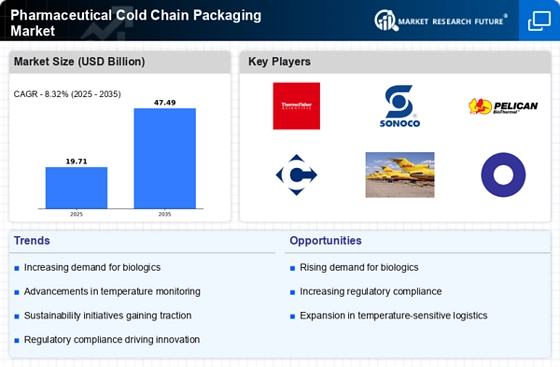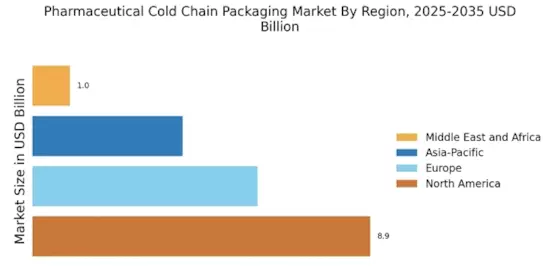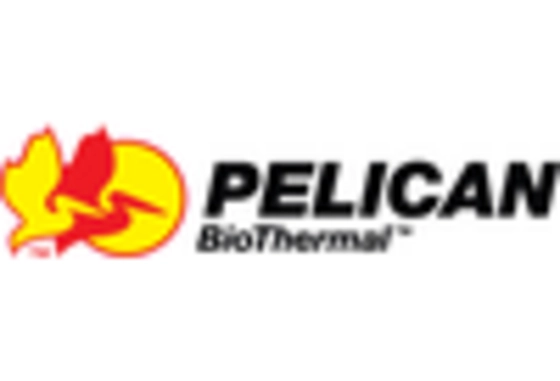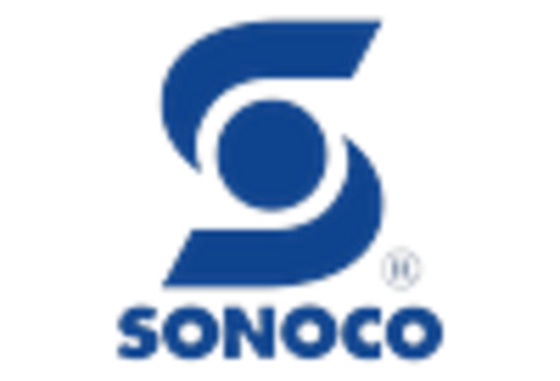Rising Demand for Biologics
The increasing prevalence of chronic diseases and the growing focus on personalized medicine are driving the demand for biologics. These products often require stringent temperature control during transportation and storage, which is where the Pharmaceutical Cold Chain Packaging Market plays a crucial role. According to recent data, the biologics market is projected to reach USD 500 billion by 2025, necessitating advanced cold chain solutions to maintain product integrity. As a result, pharmaceutical companies are investing heavily in cold chain logistics to ensure that these sensitive products are delivered safely and effectively. This trend indicates a robust growth trajectory for the Pharmaceutical Cold Chain Packaging Market, as it adapts to the evolving needs of the healthcare sector.
Expansion of Vaccine Distribution
The ongoing expansion of vaccine distribution networks is a significant driver for the Pharmaceutical Cold Chain Packaging Market. With the increasing number of vaccines being developed and distributed, particularly for infectious diseases, the need for reliable cold chain solutions has never been more critical. The market for vaccines is expected to exceed USD 100 billion by 2025, highlighting the necessity for effective cold chain management. This includes temperature-controlled packaging that ensures vaccines remain viable throughout their journey from manufacturer to end-user. Consequently, the Pharmaceutical Cold Chain Packaging Market is likely to experience substantial growth as it supports the logistics of vaccine distribution, ensuring public health initiatives are met efficiently.
Increasing Regulatory Requirements
The Pharmaceutical Cold Chain Packaging Market is significantly influenced by the increasing regulatory requirements imposed by health authorities. These regulations mandate strict adherence to temperature control standards for the transportation and storage of pharmaceuticals. Compliance with these regulations is essential for maintaining product efficacy and safety, thereby driving demand for specialized cold chain packaging solutions. As regulatory bodies continue to tighten their guidelines, pharmaceutical companies are compelled to invest in advanced cold chain systems to ensure compliance. This trend is expected to propel the Pharmaceutical Cold Chain Packaging Market forward, as companies seek to mitigate risks associated with non-compliance and product recalls.
Technological Innovations in Packaging
Technological innovations are reshaping the Pharmaceutical Cold Chain Packaging Market, enhancing the efficiency and reliability of temperature-sensitive product transport. Advanced materials and smart packaging solutions, such as temperature indicators and data loggers, are becoming increasingly prevalent. These innovations not only improve monitoring capabilities but also reduce the risk of product spoilage. The market for smart packaging is projected to grow significantly, with estimates suggesting a compound annual growth rate of over 10% through 2025. As pharmaceutical companies seek to optimize their supply chains, the integration of these technologies into cold chain packaging solutions is likely to drive growth in the Pharmaceutical Cold Chain Packaging Market.
Growth of E-commerce in Pharmaceuticals
The growth of e-commerce in the pharmaceutical sector is emerging as a pivotal driver for the Pharmaceutical Cold Chain Packaging Market. As more consumers turn to online platforms for their medication needs, the demand for efficient and reliable cold chain solutions is escalating. E-commerce sales in the pharmaceutical industry are projected to reach USD 100 billion by 2025, necessitating robust cold chain logistics to ensure product integrity during transit. This shift towards online sales channels is prompting pharmaceutical companies to enhance their cold chain packaging strategies, thereby fostering growth in the Pharmaceutical Cold Chain Packaging Market. The need for effective temperature control during last-mile delivery is particularly critical, as it directly impacts customer satisfaction and product efficacy.


















Leave a Comment